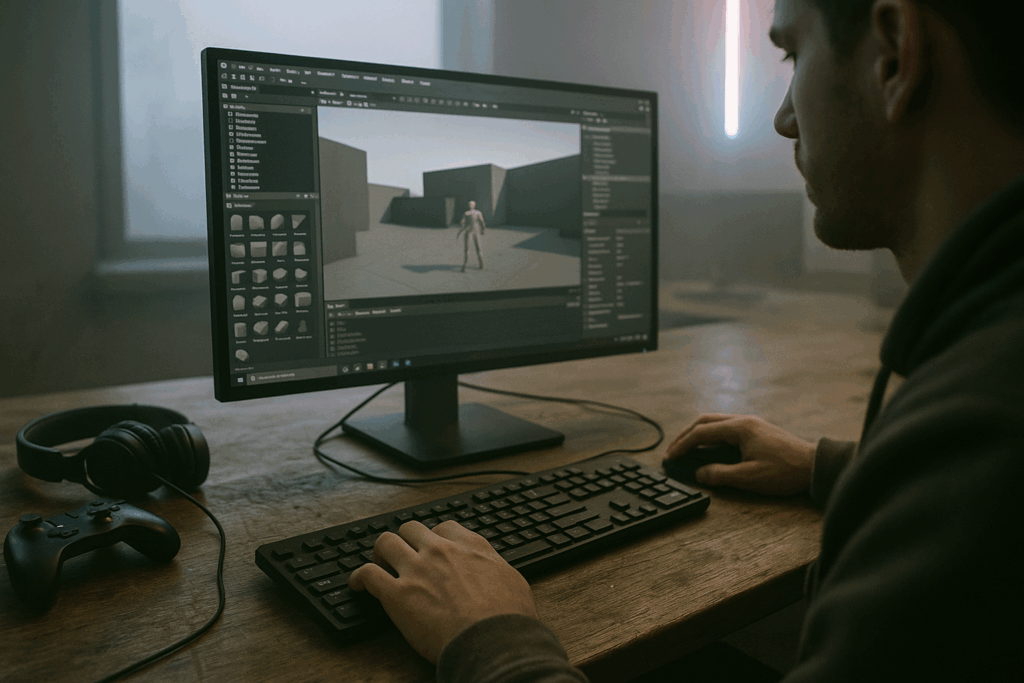Introduction: The Tools Behind the Magic
Great ideas are worth nothing if you can’t build them. That’s why having the right software stack isn’t optional—it’s fuel. As an aspiring game developer, you’re juggling design, code, art, sound, and deadlines. The right tools cut that chaos down. They speed up your workflow, reduce burnout, and let you focus on making the game instead of wrestling with your setup.
But it’s not just about having the shiniest tool—it’s about balance. Beginner-friendly doesn’t mean weak, and pro-level features don’t always justify a steep cost or learning curve. The sweet spot? Software that matches your skill level, fits your style, and grows with you. Whether you’re solo or working with a team, building on a budget or investing in your dream game, the right stack helps you get there faster.
This guide breaks down the essentials—engines, art tools, audio gear, project managers, and code editors—so you can build smarter from day one. Keep it lean. Keep it practical. And keep building.
Unity
If you’re just getting your hands dirty in game dev—or even if you’re several projects deep—Unity is a natural first stop. The engine handles both 2D and 3D with ease, making it flexible enough for everything from side-scrollers to VR sims. Built-in cross-platform support means you can push your game to console, mobile, PC, even AR platforms without rewriting your whole codebase. Add to that a massive community, tons of tutorials, and an asset store full of plug-and-play features, and it’s no wonder Unity’s still the go-to for indie devs and small studios.
Unreal Engine
When visual fidelity matters, Unreal delivers. This isn’t just about pretty graphics—it’s about cinema-level rendering paired with a powerhouse suite of development tools. Unreal’s Blueprint system lets you build full game logic without writing code (though you can go deep with C++ if needed). The engine is heavy, sure, but it’s ideal for making console-grade titles or impressively polished previews. Great for teams and creators who want to make a visual splash and don’t mind climbing a steeper learning curve to do it.
Godot
Godot is the underdog with teeth—lightweight, open-source, and increasingly capable. It shines with 2D games, and its no-strings-attached licensing makes it perfect for bootstrapped developers. New to coding? Godot’s scripting language (GDScript) is beginner-friendly but deep enough to grow with. The engine is snappy, open to modification, and iterates fast. It may lack the polish and feature depth of Unity or Unreal, but for solo or indie developers working on tight timelines (or tighter budgets), Godot packs serious punch.
Blender
Blender offers a full suite of 3D tools—modeling, animation, rigging, lighting, simulation, even basic video editing—and it’s 100% free. That’s not just generous, it’s game-changing, especially for indie developers and small teams running lean.
Its built-in render engines, Eevee and Cycles, handle real-time and photorealistic rendering. So whether you’re prepping assets for your game world or animating cutscenes, Blender has you covered. What used to take a whole pipeline of overpriced software can now be done in one place. It’s no wonder more devs are treating Blender like their creative command center.
Photoshop & Alternatives (e.g., GIMP, Krita)
When it comes to 2D work—textures, UI graphics, sprite sheets—Photoshop is still a powerhouse. Its layer system alone can seriously streamline your workflow once you know how to use it properly. But not everyone can or wants to pay the monthly price tag.
That’s where free tools like GIMP and Krita come in. GIMP mimics much of Photoshop’s core functionality, and Krita is particularly strong in digital painting and concept work. The key isn’t which program you use—it’s how well you can manipulate layers, masks, and brushes to produce what you need. Master the basics, and the software becomes secondary.
Audacity
Audacity is a no-fuss audio editor that’s been a go-to for creators for years—and for good reason. It’s open-source, lightweight, and does the job without getting in your way. Whether you’re recording voiceovers, trimming clips, or cleaning up background noise, Audacity handles it with minimal setup. Want to normalize levels or drop in some basic effects? It’s got you covered. It’s not flashy, but it’s reliable—which is exactly what you want when you’re deep into game dev and don’t have time to troubleshoot clunky software.
FMOD or Wwise
When your game needs dynamic audio—footsteps changing based on terrain, music that shifts with tension, or combat sounds reacting to real-time input—middleware like FMOD or Wwise is where you level up. They sit between your game engine and your audio assets, letting you build interactive sound systems without hard-coding every minor event. Both tools are widely used across the industry, and choosing one comes down to workflow preference and engine compatibility. For devs serious about immersive experience, they’re essential pieces of the audio puzzle.
Trello / Notion / Miro
Scope creep is a silent killer—these tools help you see it coming. Trello and Notion are staples for keeping your ideas, features, and progress grounded. Use them to break down your game into realistic phases: core mechanics, polish, launch tasks. Organizing the madness keeps dev fatigue in check.
Miro shines when your team needs a shared visual brain. Think flowcharts of player progression or UI mockups that evolve while everyone’s watching. Whether solo or collaborative, these tools help map timelines, set priorities, and flag bugs before they escalate.
Git & GitHub/GitLab
You’re not a developer until you use version control. Git tracks changes to your codebase—so you can test wildly without fear of breaking your build. GitHub and GitLab also let you roll back updates, fork ideas, and manage team contributions without playing file-name roulette (“player_final2_finalFIXED_thisoneREAL.cs”).
Even if you’re working solo, learn Git early. It’s not sexy, but it’s essential. Plus, most game engines already offer Git integration out of the box. The sooner you version your work like a pro, the sooner you stop fearing mistakes—and start building with confidence.
Programming Environments
Choosing the right Integrated Development Environment (IDE) can significantly impact your productivity and workflow as an aspiring game developer. Whether you’re scripting gameplay mechanics or debugging new features, a reliable coding environment is essential.
Visual Studio / VS Code
These two Microsoft-developed tools remain top choices for many game developers.
Why Use Them:
- Language Support: Ideal for C#, C++, and Python development, depending on your game engine.
- Adaptable and Extensible: VS Code offers a lightweight, customizable experience with thousands of extensions.
- Debugging Power: Breakpoints, watch windows, real-time variable inspection—all built right in.
- Engine Integration: Especially with Unity (C#), Visual Studio integrates seamlessly and is the default IDE.
When to Choose:
- If you’re developing with Unity, use Visual Studio for robust support and dependable performance.
- If you prefer a slim interface with more control, VS Code gives you flexibility without bloat.
JetBrains Rider
For developers seeking a powerhouse IDE with enhanced productivity tools, JetBrains Rider stands out—especially for Unity-focused projects.
Key Features:
- Unity-Optimized: Built-in Unity support offers real-time asset inspection, play mode debuggers, and serialized field navigation.
- Cross-Platform Fluent: Works smoothly across Windows, macOS, and Linux for collaborative, multi-platform projects.
- Intelligent Code Assistance: Advanced refactoring tools, code suggestions, and inspections to streamline your development.
When to Invest:
- If you’re a Unity developer working on complex projects or large teams, Rider offers an edge in long-term efficiency.
- It’s ideal for those who need premium features beyond what free options offer.
Experimenting with different IDEs during early development can help you find the right fit for your engine and workflow. Whatever tool you settle on, prioritize stability, speed, and comfort—you’ll be spending a lot of time here.
Final Tips: Finding What Works for You
There’s no one-size-fits-all software stack in game development. Tools that work beautifully for a solo dev on a 2D pixel game might be total overkill for a small team building a high-fidelity 3D experience. The only way to know what clicks for you is to test, iterate, and be brutally honest about what you actually need—and what you don’t.
Consider your scope. Are you making a mobile puzzle game or launching into open-world survival territory? Your platform choice alone changes the toolset. Then factor in your team size. One-person shops need compact, multifunctional tools. Larger teams can afford more specialization. And experience level matters: beginners don’t need pro software right out of the gate—pick tools you can grow with.
Early on, keep your setup lean. Fewer tools mean fewer things that can break, clash, or slow you down. Nail the basics, get something playable, and refine from there.
Looking to build your physical workspace too? Check out Building the Ultimate Gaming Setup: Equipment and Ideas
Conclusion
Ultimately, the tools you use are just that—tools. They’re only as powerful as the hands guiding them. Great games don’t come from feature-packed menus or perfect plug-ins. They come from putting ideas into action, pushing through roadblocks, and shipping something real.
So, don’t chase flashy software. Pick tools that help you stay focused and in flow. If switching between five apps breaks your rhythm, simplify. Stick to what’s necessary. Learn it well. Get things done.
Consistency beats complexity. Master the basics of your game engine, get comfortable with your art workflow, and track your progress without overbuilding systems. Flexibility is key—tools change, features shift, but your ability to adapt is what will keep you moving forward.
In the end, it’s not about having the perfect stack. It’s about executing. Build the game. Then build the next one. That’s how you grow.




